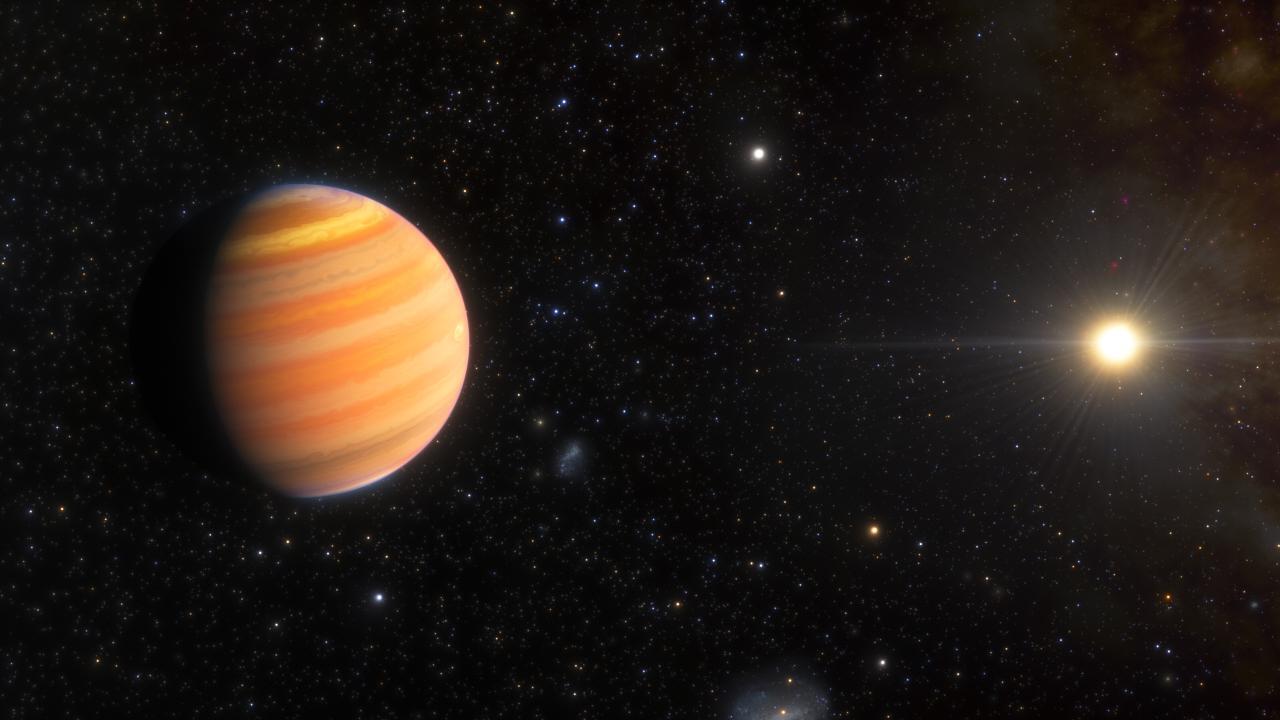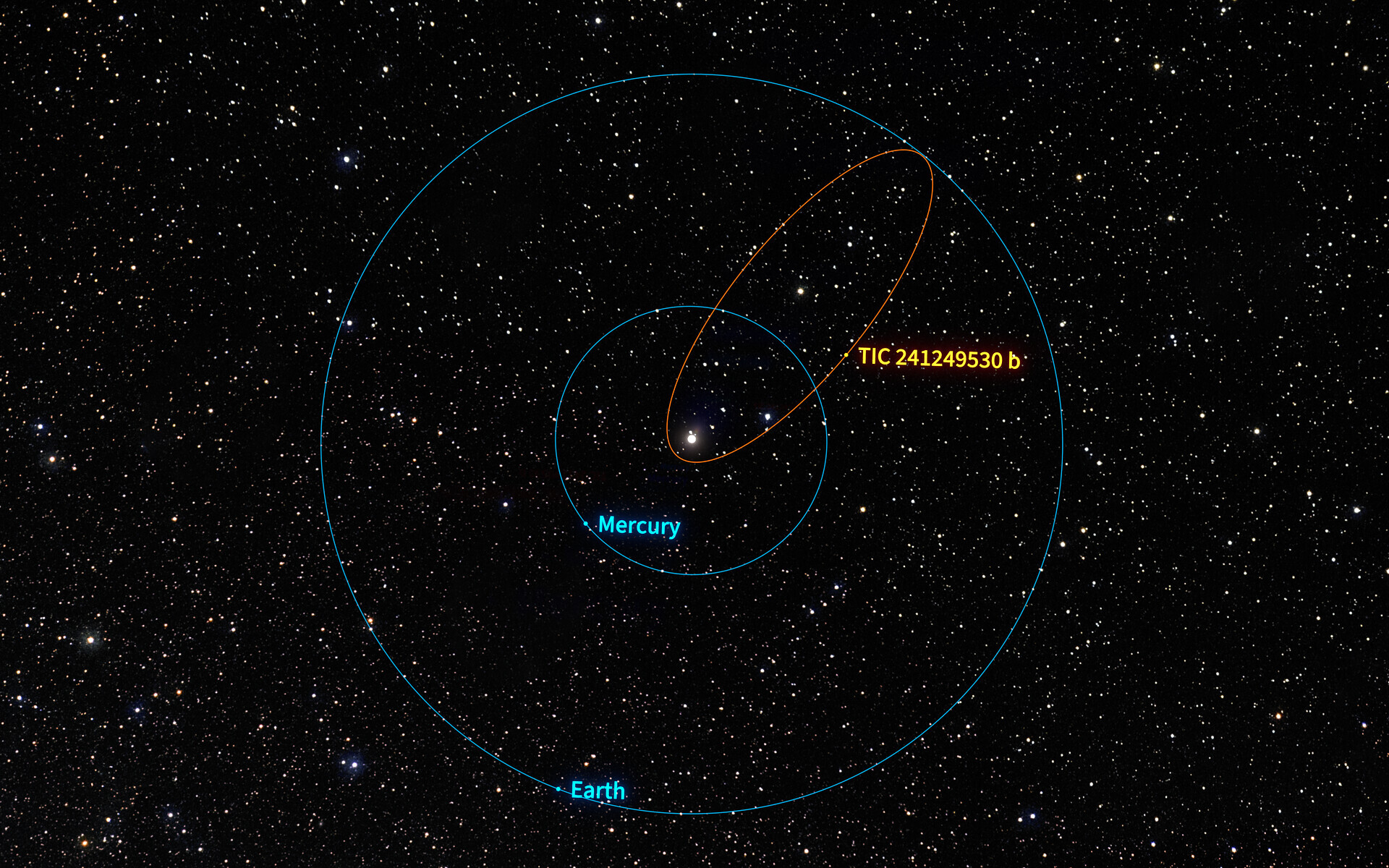18.07.2024

Artist’s impression of TIC 241249530 b, a gas giant exoplanet that is on its way to becoming a hot Jupiter. Credit: NOIRLab/NSF/AURA/J. da Silva
An international scientific team, in which the Instituto de Astrofísica de Canarias (IAC) participates, has discovered the extremely eccentric orbit of a gas giant exoplanet. This world, called TIC 241249530 b, not only follows one of the most drastically stretched-out orbits of all known transiting exoplanets, but also is also orbiting its star backwards, lending insight into the mystery of how these high-mass gas giants evolve into hot Jupiters, with very close and circular trajectories. The study is published in Nature.
Within the population of known exoplanets, there are those that belong to the class known as hot Jupiters: large, Jupiter-like exoplanets that orbit very close to their star, some even closer than Mercury to our Sun. How hot Jupiters end up in such close orbits is a mystery, as they cannot form there, but astronomers postulate that they begin in orbits far from their star and then migrate inward over time.
The early stages of this process have rarely been observed, but a new analysis of the exoplanet TIC 241249530 b, detected by NASA's Transiting Exoplanet Survey Satellite (TESS) in 2020, has revealed that its orbit is extremely eccentric, describing an ellipse with one axis much larger than the other. This peculiar trajectory suggests that the planet is in a hot Jupiter pre-migration phase. The data also confirmed that the exoplanet is about five times more massive than Jupiter.
TIC 241249530 b is only the second exoplanet ever discovered that is at a point in its evolution prior to its migration into tighter orbits. The detection of such exoplanets observationally affirm the idea that higher-mass gas giants evolve to become hot jupiters as they move from highly eccentric orbits toward closer, more circular orbits. This process is due to the fact that, as it approaches the host star, the tidal forces on the planet sap energy from the orbit and cause it to gradually shrink and circularize.
“While we can’t exactly press rewind and watch the process of planetary migration in real time, this exoplanet serves as a sort of snapshot of the migration process,” says Arvind Gupta, a NOIRLab postdoctoral researcher and lead author of the paper published in Nature. “Planets like this are incredibly rare and hard to find, and we hope it can help us unravel the hot Jupiter formation story.”

This illustration shows the orbit of the newly discovered Jupiter-like exoplanet named TIC 241249530 b, shown in comparison to the orbits of Mercury and Earth in our own Solar System. TIC 241249530 b follows one of the most stretched-out orbits of any transiting exoplanet known and also orbits its host star backwards, meaning in the direction opposite the star’s rotation. Credit: NOIRLab/NSF/AURA/R. Proctor
The eccentricity of a planet’s orbit is measured on a scale from 0 to 1, with 0 being a perfectly circular orbit and 1 being highly elliptical. This exoplanet has an orbital eccentricity of 0.94, making it more eccentric than the orbit of any other exoplanet ever found via the transiting method. For comparison, Pluto’s highly elliptical orbit around the Sun has an eccentricity of 0.25; Earth’s eccentricity is 0.02.
If this planet was part of our Solar System its orbit would stretch from its closest approach ten times closer to the Sun than Mercury all the way out to its most distant extent at Earth’s distance. This extreme orbit would cause temperatures on the planet to vary between that of a summer’s day to hot enough to melt titanium.
the team also found that TIC 241249530 is orbiting backwards, meaning in a direction opposite to the rotation of its host star. This is not something that astronomers see in most other exoplanets, nor in our own Solar System, and it helps inform the team’s interpretation of the exoplanet’s formation history.
For the investigation, the team used the WIYN 3.5-metre telescope at the US National Science Foundation Kitt Peak National Observatory (KPNO), a Program of NSF NOIRLab. In the near future, the team plans to learn more about the atmosphere of TIC 241249530 b through observations with more powerful telescopes such as the James Webb Space Telescope (JWST).
"We’re especially interested in what we can learn about the dynamics of this planet's atmosphere after it makes one of its scorchingly close passages to its star," says Enric Pallé, a researcher at the IAC and co-author of the study. "Telescopes like JWST have the sensitivity to probe the changes in the atmosphere of the newly discovered exoplanet as it undergoes rapid heating, so there is still much more for the team to learn about the exoplanet."
“Astronomers have been searching for exoplanets that are likely precursors to hot Jupiters, or that are intermediate products of the migration process, for more than two decades, so I was very surprised — and excited — to find one,” Gupta concludes. “It’s exactly what I was hoping to find.”
Quelle: Instituto de Astrofísica de Canarias
